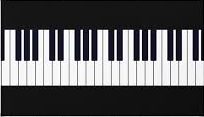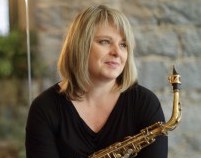Story by Nick Krewen | October 28, 2014
For SOCAN’s Words and Music
“There’s a way of playing safe, there’s a way of using tricks and there’s the way I like to play, which is dangerously, where you’re going to take a chance on making mistakes in order to create something you haven’t created before.”
The late Dave Brubeck wasn’t Canadian, nor was he a SOCAN member, but the quote attributed to him could easily describe a number of SOCAN members who are exploring jazz and taking the genre in bold, innovative new directions.
Canada has been blessed with pioneering artists like pianist Oscar Peterson, arranger Gil Evans, guitarist Lenny Breau and big band-leading trombonist Rob McConnell forging trailblazing reputations in the past, but 2014 has its own share of groundbreakers: bands like Bad Bad Not Good with their hip-hop sensibilities; composers like soul-jazz experimenter Elizabeth Shepherd; Kellylee Evans, whose breathtaking interpretations of rap have been eye-opening; The Heavyweights Brass Band, who put an old-time spin on contemporary standards and new originals; and adventurous trio Myriad3, who are forging their own lexicon.
“I placed myself in that tradition of people who have found ways to hack the big band.” – Darcy James Argue
And there are these four: Darcy James Argue’s Secret Society, Christine Jensen, Colin Stetson and Jane Bunnett’s latest project, Maqueque (pronounced mah-KAY-kay).
On the big-band front, Vancouver-born Darcy James Argue and Montreal’s Christine Jensen each offer their own distinctive takes on the 18-member format with their recent efforts Brooklyn Babylon and Habitat, respectively, both to international critical acclaim.
Argue, who has been twice nominated for Grammy Awards for 2010’s Infernal Machines and 2013’s Brooklyn, takes credit for self-labeling his music “steampunk big band,” a sound that references everyone from the Thad Jones/Mel Lewis era to Monty Python fave John Philip Sousa, and veers from minimalism to a full funk blowout.
“I was taking some pretty old-school musical technology full of brass, hijacking it, and making it do something it wasn’t originally designed to do,” Argue explains from his New York home. “The big band is so strongly associated with a particular time and place in history, but there have always been the freaks and weirdos of the jazz world who have clung to, and have found innovative usage for, this particular instrumentation that is wildly divergent from the sound of the big band era. By claiming that label, I placed myself in that tradition of people who have found ways to hack the big band.”
Argue, who spent time studying music at Montreal’s McGill University, was invited by trombonist Bob Brookmeyer – “a great mentor of mine and a master of big band writing,” says Argue – to study at the New England Conservatory of Music.
“They had something totally unique – a student big band, devoted entirely to student compositions, that meets every week,” Argue recalls. “This was a great opportunity for me to hone my skills.”
Argue admits that he never intended to specialize in big band, but his time at the New England Conservatory helped focus his sound.
“I really became enraptured with the possibilities of writing music on a larger scale, having the ability to have dense harmony and counterpoint, and wider tone palettes than you have in a small group,” says Argue. “There’s also the kind of intricacy and raw power that comes from having 14 brass and wind players blowing right in your face. It’s an experience you can’t really duplicate. It became something that I couldn’t live without.”
Christine Jensen has a similar tale in terms of unexpectedly tackling a larger ensemble, although the alto saxophonist prefers the term “jazz orchestra” to “big band.”
“It’s my music and it’s a bit contemporary,” she explains. “It’s not easy listening – there are challenges in the composition for the listener to hear new ideas.”
Scoring rave international reviews and a JUNO Award for her latest album Habitat, Jensen – the sister of renowned Canadian trumpeter Ingrid Jensen (who plays in Argue’s Secret Society) – says the album’s inspiration grew out of her prior small ensemble release, Treeline.
“It took me a long time to get the courage to go into the studio with a large band and really lay it down [for Habitat],” admits Jensen. “It also took me a lot of time in post-production to figure out the sound, because there’s a lot of ways you can go with that many musicians. I ended up getting four extended compositions together, and then added a few from my old repertoire that hadn’t been previously recorded.”
Jensen says that jazz represents her ideal form of expression. “Whether I’m playing by myself or with 20 other people, it’s about communication,” she says. “It’s about putting your own sound on top of a sketch or a lead sheet or an idea from a composer’s point of view. It’s just as important to express myself through the saxophone, as an improviser in the moment. That’s why everyone calls jazz the music of freedom.”
“It took me a long time to get the courage to go into the studio with a large band and really lay it down.” – Christine Jensen
For Ann Arbor, Michigan-born and Montreal-based multi-reed player Colin Stetson, that freedom extends to the physical. His New History Warfare solo album trilogy is inspired by the sweat he pours into his trademark bass saxophone.
Using techniques such as circular breathing and overblowing, Stetson – who’s also played studio musician to Tom Waits, Arcade Fire and Bon Iver, among others – pushes the envelope, uttering drones and Philip Glass ostinato patterns as part of his fascinating sonics.
“The solo writing, though not exclusively, tends to come from the physicality of the instrument,” says Stetson. “It always has to come from there, because ultimately I’m coaxing a certain palette out of it.
“There are times when I have ideas and more fleshed-out themes for full songs. I’ll bring that to an instrument and contextualize it. Ultimately, everything is filtered through the medium of my instrument and the way that I can play it.”
Saxophonist and flautist Jane Bunnett, a Canadian den mother of Cuban musicians, is breaking gender boundaries as well as sonic ones. Her latest album, Maqueque, introduces and earmarks the numerous talents of young female Cuban musicians, a stark counterpoint to that country’s male-dominated music scene.
She discovered them during her annual jaunts to Cuba on behalf of The Spirit of Music Foundation, launched by Bennett and her husband, trumpeter Larry Cramer, to take instruments to the country over the past 25 years.
“We’ve gone into the schools and a good 60 to 70 percent of the audience are young girls,” says Bunnett. “I just found it so surprising that there weren’t a lot of instrumentalists out on the scene.”
Bunnett says she met singer/percussionist Daymé Arceno, 18 at the time, during one of the couple’s Cuban sojourns and was immediately impressed. “She held her own with some of the legendary Cuban guys and I was very impressed by her chutzpah,” recalls Bunnett. “She sang well beyond her years, and I found out she loved to compose.”
Comprised of Arceno and her fellow Cubans Yissy García on drums, Yusa on guitar and fretless bass, Danae Olano on piano and Magdelys Savigne on percussion – all but Yusa in their early 20s – with Bunnett herself on soprano sax and flute, Maqueque is named for a word translates into “the spirit of a little girl.”
“We’ve got this really great combination of instruments and vocals I’ve kept in play,” says Bunnett of Maqueque, which has garnered enthusiastic album and live reviews throughout Canada.
In the true spirit of jazz, and in the true spirit of being Canadian, the frontiers of adventure await.
Given space constraints, it was not possible to mention all of the SOCAN members who are forging new directions in jazz.

